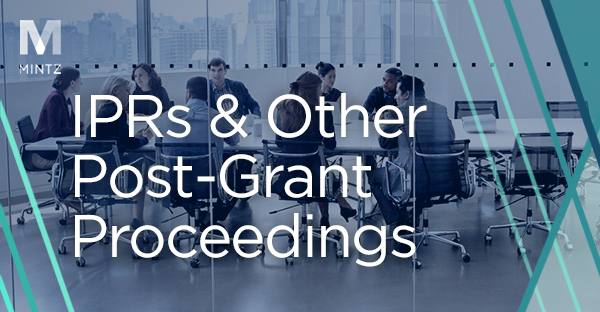Tip #5 for Avoiding IPR Institution: Policing KSR’s motivation requirement for the ‘how’ and ‘why’.
Building on Tip #4, one effective way to avoid institution and not address facts is to point out shortcomings in the petition's application of KSR when asserting motivation to combine for an obviousness analysis. The Patent Trial and Appeal Board (“PTAB”) is an administrative tribunal that frequently encounters proposed grounds that challenged claims are obvious pursuant to 35 U.S.C. ¶103. As a result, the PTAB and its reviewing court, the Federal Circuit, have had numerous opportunities over the years to clarify the evidentiary burden for demonstrating that challenged claims are obvious over combinations of prior art. Chief among those is the requirement that Petitioners come forward with a properly supported explanation of “how” and “why” a person of skill in the art would have made any required modifications to arrive at the claimed invention. The PTAB strictly adheres to this legal requirement of KSR Int’l Co. v. Teleflex Inc.[1] (“KSR”) and frequently references it in decisions denying institution. As a result, patent owners should evaluate whether petitions challenging their patent claims have adequately recited and supported a rational motivation to combine. This approach has the benefit of attacking entire grounds without raising questions of fact—a core consideration, as we have previously discussed.
When the Supreme Court issued its KSR decision in 2007, it replaced the “teaching-suggestion-motivation” (TSM) test previously used by the Federal Circuit with a more flexible standard that allowed for common sense to intercede in situations such as those where a person of ordinary skill might only need to navigate a finite number of identifiable and predictable solutions within his or her technical grasp. While the Supreme Court found that the Federal Circuit’s rigid application of the “TSM” test for obviousness to be incompatible with its precedents, it left intact an important guard against hindsight rationales: the need to identify a reason that would have prompted a person of skill to combine prior art elements in the same way that the claimed invention does.
A petitioner’s mere identification of where each claim limitation can purportedly be found in the prior art and thus available to a person of ordinary skill in the art is normally not enough to demonstrate that the claims are unpatentable as obvious. Even if such an identification includes an explanation of how to meet all of the limitations of the challenged claims, the petitioner must also explain why a person of ordinary skill in the art would have proceeded to combine the selected prior art in the proposed way to reach the claimed invention. As the Federal Circuit has explained, “obviousness concerns whether a skilled artisan not only could have made but would have been motivated to make the combinations or modifications of prior art to arrive at the claimed invention.”[2] Accordingly, a familiar refrain in institution denials is the necessity that petitioners provide at least “some articulated reasoning with some rational underpinning to support the legal conclusion of obviousness.”[3] A common error is the failure to do so. As of the time of this writing, the PTAB has quoted that refrain from In re Kahn in more than one hundred institution denials since 2015.[4] And the Federal Circuit has held the Board to the same standard when reviewing final written decisions determining that claims are obvious based on combinations of prior art elements.[5]
As the PTAB appropriately explained in one institution decision, “[a]n assertion that something could be done does not articulate a reason why something would be done by one of ordinary skill in the art at the time of the invention and, therefore, raises a specter of impermissible hindsight bias in an obviousness analysis.”[6] Patent Owners can and should guard against hindsight reconstructions of the prior art at the institution stage by making certain that the petition offers an adequate explanation as how and why the prior art would have been combined. Without such information, the petitioner has likely not met its burden of demonstrating a reasonable likelihood of prevailing with respect to at least 1 challenged claim.
Our next and final post in this series of Tips for Avoiding IPR Institution will publish November 16 and focuses on advocating claim constructions that if adopted will defeat institution.
* The content of this post does not constitute legal advice and we recommend you discuss options with your attorney prior to making legal decisions.
[1] 550 U.S. 398, 418 (2007).
[2] Belden Inc. v. Berk-Tek LLC, 805 F.3d 1064, 1073 (Fed. Cir. 2015) (emphasis in original).
[3] See In re Kahn, 441 F.3d 977, 988 (Fed. Cir. 2006).
[4] Based on Lex Machina data analysis.
[5] See e.g., In re NuVasive, Inc., 842 F.3d 1376, 1382 (Fed. Cir. 2016); In Re Schweickert, 676 Fed. Appx. 988, 995 (Fed. Cir. 2017); Sirona Dental Sys. v. Institut Straumann AG, 892 F.3d 1349, 1358 (Fed. Cir. 2018).
[6] Nautilus Hyosung Inc. v. Diebold Self-service Systems division of Diebold, IPR2016-00633, Paper 9 at 21 (PTAB Aug. 22, 2016).

Tip #4 for Avoiding IPR Institution: Don’t Argue Facts
November 9, 2020| Blog

Tip #3 for Avoiding IPR Institution: Use Disclaimers Strategically
November 5, 2020| Blog
Authors
Peter J. Cuomo
Member


